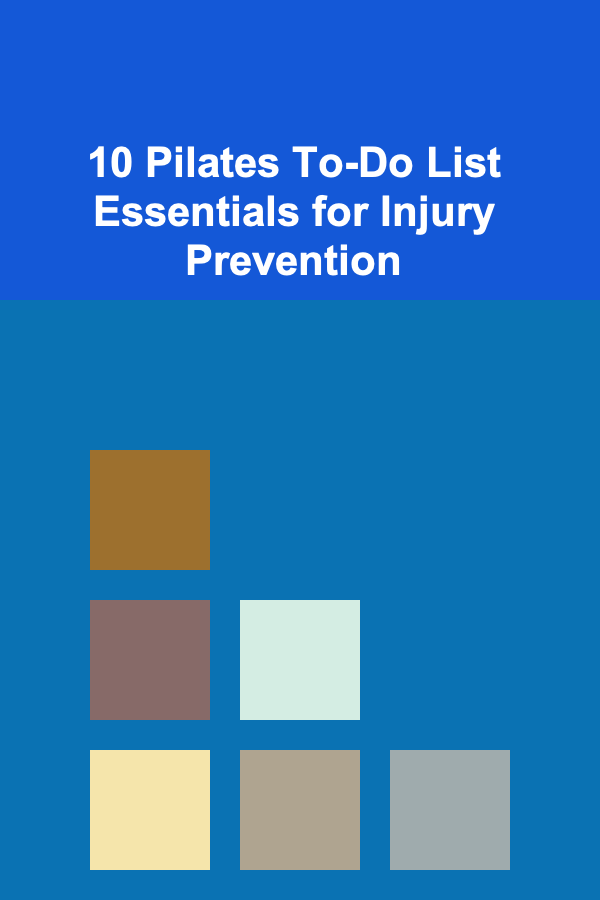
10 Pilates To-Do List Essentials for Injury Prevention
ebook include PDF & Audio bundle (Micro Guide)
$12.99$7.99
Limited Time Offer! Order within the next:

Pilates, a method of physical fitness developed in the early 20th century by Joseph Pilates, has become one of the most popular forms of exercise worldwide. It emphasizes core strength, flexibility, balance, and mindful movement, making it an excellent choice for individuals seeking a low-impact, full-body workout. However, like any physical activity, Pilates carries a risk of injury if not performed correctly or without proper preparation.
In this comprehensive article, we will explore 10 essential to-do list items that can help you prevent injury while practicing Pilates. Whether you are a beginner or an experienced practitioner, these essentials will deepen your understanding of safe Pilates practice, enhance your body awareness, and ultimately improve your overall performance and well-being.
Understand Your Body's Limits and Conditions
Before stepping onto the Pilates mat, it's crucial to have a clear understanding of your body's current physical condition, limitations, and any pre-existing injuries or health issues.
Why This Matters:
- Pilates involves controlled movements that require strength, flexibility, and coordination.
- Ignoring your body's restrictions can lead to exacerbation of old injuries or the development of new ones.
- Tailoring exercises to your individual needs helps prevent strain or overuse.
Practical Steps:
- Consult a healthcare professional or physical therapist if you have any chronic conditions or recent injuries.
- Discuss your goals and any concerns with your Pilates instructor.
- Start with beginner-level classes or private sessions to assess your fitness safely.
- Communicate openly with your instructor about any discomfort during exercises.
By understanding and respecting your body's unique needs, you create a safer Pilates practice and foster long-term health.
Prioritize Proper Warm-Up and Mobility Work
A well-structured warm-up is essential before any Pilates session. Warm muscles and joints improve performance and decrease the likelihood of injury.
Why This Matters:
- Pilates requires muscle engagement and flexibility, which can be compromised when cold.
- Gradually increasing your heart rate and warming connective tissues helps reduce stiffness.
- Warm-ups enhance proprioception (body awareness), a key component in Pilates.
Practical Steps:
- Incorporate gentle cardiovascular movements like marching or arm swings for 5--10 minutes.
- Include dynamic stretches targeting the spine, hips, shoulders, and hamstrings.
- Focus on joint mobilization exercises, such as spinal articulation and ankle circles.
- Use breath work to prepare mentally and physically for your Pilates session.
This preparation primes your body, enabling you to execute Pilates movements with better control and less risk of injury.
Master Fundamental Pilates Principles
Pilates is more than just exercises; it's a mindful movement practice grounded in six fundamental principles that guide every movement: concentration, control, centering, flow, precision, and breathing.
Why This Matters:
- Adhering to these principles ensures that exercises are performed with proper technique.
- Proper technique minimizes stress on joints and soft tissues.
- Mindful movement reduces the chance of compensations that lead to injury.
Breakdown of Principles:
- Concentration: Stay mentally focused on each movement to execute it correctly.
- Control: Avoid relying on momentum; every movement should be deliberate.
- Centering: Engage the core or "powerhouse" muscles to stabilize your body.
- Flow: Movements should be smooth and continuous, not jerky or rushed.
- Precision: Aim for exactness in form rather than speed or quantity.
- Breathing: Coordinate breath with movement to support stability and oxygenate muscles.
Understanding and applying these principles consistently forms the foundation of safe Pilates practice.
Focus on Core Engagement and Stability
The core is the powerhouse of Pilates, often referred to as the "powerhouse." Proper core engagement is vital for spinal support and injury prevention.
Why This Matters:
- A strong and stable core protects the lower back and pelvis during movement.
- Lack of core engagement leads to compensatory movements that increase injury risk.
- Core stability improves posture and overall functional strength.
Practical Steps:
- Learn to activate the transverse abdominis (deep abdominal muscles) gently.
- Practice pelvic floor engagement alongside abdominal activation.
- Use cues like "drawing the navel toward the spine" without holding your breath.
- Avoid overusing superficial muscles like the rectus abdominis during Pilates movements.
With consistent practice, core engagement becomes second nature, creating a solid foundation for all Pilates exercises.
Maintain Proper Alignment and Posture
Body alignment is a critical aspect of Pilates technique that influences movement efficiency and injury prevention.
Why This Matters:
- Misalignment can place uneven stress on joints, muscles, and connective tissues.
- Proper posture supports optimal biomechanics during exercises.
- Alignment awareness improves proprioception and body control.
Key Alignment Points:
- Neutral spine position: maintain the natural curves of the cervical, thoracic, and lumbar spine.
- Shoulder blades: keep them relaxed and down, away from the ears.
- Hips: level and aligned with knees and feet.
- Head: aligned over the spine, not jutting forward.
Practical Steps:
- Use mirrors or record yourself to observe alignment during practice.
- Ask an instructor for feedback and adjustments.
- Engage postural muscles, including deep spinal stabilizers and scapular stabilizers.
Prioritizing alignment prevents compensations that can cause repetitive strain or acute injuries.
Use Props and Modifications Appropriately
Pilates offers a variety of props such as resistance bands, balls, blocks, and reformer machines that can enhance or modify exercises.
Why This Matters:
- Props provide support, increase challenge, or assist in correct form.
- Modifications allow adaptations for different fitness levels or injuries.
- Proper use of props prevents overextension or incorrect movement patterns.
Practical Tips:
- Use props to support joints during challenging movements, e.g., a small ball between knees to engage inner thighs.
- Modify exercises based on your ability and comfort---e.g., reduce range of motion or avoid certain poses.
- Avoid pushing through pain by adjusting or skipping exercises as needed.
- Seek guidance from a trained Pilates instructor on correct prop usage.
Using props mindfully can enhance safety and effectiveness in your Pilates routine.
Progress Gradually and Respect Your Pace
Progression is key in Pilates, but it must be approached with caution to avoid overuse injuries.
Why This Matters:
- Overloading muscles or joints too quickly leads to strain and setbacks.
- Gradual progression builds sustainable strength and flexibility.
- Listening to your body reduces frustration and burnout.
Practical Steps:
- Begin with foundational exercises and master them before advancing.
- Increase intensity by adding repetitions, resistance, or complexity slowly.
- Incorporate rest days and cross-training for recovery.
- Pay attention to signs of fatigue or discomfort, and adjust accordingly.
Respecting your pace allows your body to adapt safely, supporting long-term Pilates success.
Incorporate Rest and Recovery
Rest is an often overlooked but essential element in injury prevention for any exercise, including Pilates.
Why This Matters:
- Muscles and connective tissues need time to repair and strengthen.
- Overtraining increases the risk of repetitive strain injuries.
- Mental rest enhances focus and motivation during Pilates sessions.
Recovery Strategies:
- Schedule regular rest days between Pilates workouts.
- Use active recovery such as gentle stretching, walking, or yoga.
- Prioritize sleep and hydration for optimal healing.
- Practice self-massage or foam rolling to relieve muscle tension.
Adequate recovery ensures that Pilates practice remains a positive and safe experience.
Maintain Mindful Breathing Throughout Practice
Breathing is a fundamental part of Pilates, integral to movement control and injury prevention.
Why This Matters:
- Proper breathing stabilizes the core and supports oxygen delivery to muscles.
- Breath coordination prevents holding tension and encourages relaxation.
- Breath control improves endurance and focus.
Breathing Techniques:
- Inhale through the nose, expanding the rib cage laterally.
- Exhale fully through the mouth or nose while engaging the core.
- Coordinate breaths with specific phases of movement (e.g., exhale during exertion).
- Avoid shallow chest breathing or breath-holding.
Mindful breathing enhances movement efficiency and reduces unnecessary strain.
Seek Professional Guidance and Continuous Learning
Pilates, while accessible, involves complex movements that benefit greatly from expert instruction, especially to prevent injury.
Why This Matters:
- Certified instructors provide personalized feedback and corrections.
- Guidance ensures exercises match your needs and capabilities.
- Ongoing learning keeps your practice safe and effective.
Practical Advice:
- Attend classes taught by qualified Pilates professionals.
- Schedule occasional private sessions for tailored adjustments.
- Stay informed about new Pilates research and techniques.
- Don't hesitate to ask questions or voice concerns during sessions.
Professional guidance is a key safety net, helping you progress confidently while minimizing injury risk.
Conclusion
Pilates offers a myriad of benefits, from improved core strength and flexibility to better posture and body awareness. However, to fully enjoy these benefits without injury, it is crucial to adopt a mindful, informed approach to your practice. By understanding your body's limits, prioritizing warm-up, mastering Pilates principles, engaging your core, maintaining alignment, using props correctly, progressing gradually, incorporating rest, breathing mindfully, and seeking professional guidance, you establish a robust foundation for injury prevention.
Implementing these 10 essentials transforms Pilates from a simple exercise routine into a lifelong practice of safe, effective movement and wellness. Your body will thank you for the care and respect you invest in it, leading to a stronger, more balanced, and resilient self.
If you want, I can also help you with detailed exercise examples or how to integrate these essentials into your daily Pilates routine!
Reading More From Our Other Websites
- [Survival Kit 101] How to Customize a Survival Kit for High‑Altitude Mountaineering Expeditions
- [Sewing Tip 101] 10 Essential Hand‑Sewing Stitches Every Beginner Should Master
- [Toy Making Tip 101] Safety First: How to Choose Child‑Friendly Materials for Homemade Toys
- [Organization Tip 101] How to Store Travel Gear Neatly in Your Entryway
- [Home Budget 101] How to Save Money on Heating and Cooling Your Home
- [Personal Care Tips 101] How to Apply Dry Shampoo for a Fresh Look
- [Home Pet Care 101] How to Set Up the Perfect Aquarium for Fish
- [Home Pet Care 101] How to Maintain Your Pet's Mental Stimulation at Home
- [Personal Care Tips 101] How to Deal with Menstrual Cramps Naturally
- [Mindful Eating Tip 101] From Plate to Peace: The Science Behind Mindful Eating and Portion Awareness

How to Set Up a Family Game Zone That Everyone Will Love
Read More
Top Benefits of Consignment Shopping You Didn't Know About
Read More
How to Navigate the Solar System
Read More
How To Identify Birds by Their Vocalizations
Read More
How to Cure Meats at Home (Basic)
Read More
Crafting Exotic Coffee Drinks from Around the World
Read MoreOther Products

How to Set Up a Family Game Zone That Everyone Will Love
Read More
Top Benefits of Consignment Shopping You Didn't Know About
Read More
How to Navigate the Solar System
Read More
How To Identify Birds by Their Vocalizations
Read More
How to Cure Meats at Home (Basic)
Read More